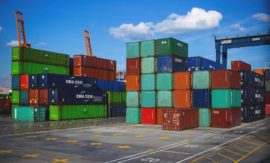Intended learning outcomes: Produce an overview on business objects such as item, specializations thereof (particularly part and component), and item family.
According to [ASCM22], some terms get a specialized definition (cf. Section 1.1.1):
- An item as a business object is any unique manufactured or purchased part, material,
intermediate, subassembly, or product. - A part as a business object is generally an item that is used as a component and is not an
assembly, subassembly, blend, intermediate, etc. - A component as a business object is the raw material, part, or subassembly that goes into a higher
assembly, compound, or other item.
From the company’s perspective, the collective term item includes the following specializations, also called item types:
- An end product or end item or finished good is a completed item that generally does not serve as a component of another product.
- An intermediate product or a semifinished good is stored or awaits final operations in the production process. It can be used in the assembly of a higher-level product and is thus also a component.
- An assembly is an intermediate product and is composed of at least two components.
- A single part (often simply called part) is either produced in-house (in-house part) or purchased (purchased part) and is used in an end item. An in-house part is produced from only one component.
- A raw material is, for the company, a purchased item or an original material that is converted via the manufacturing process.
- A service part or a spare part is a component that can be used without modification to replace a part or an assembly.
- A MRO item is an item for maintenance, repair, and operating supplies. It supports activities in the company and is, in general, not used as a component for products.
As the majority of the basic descriptions (or attributes) of all these types of items are the same, such as identification, description, inventory, costs, and price, they are often grouped together in the generalized object item. Figure 1.2.2.1 shows the item types as specializations of item.
Fig. 1.2.2.1 The business object item as a generalization of various goods objects.
An item family is a group of items having similar features (such as form, material) or a similar function.
For example, different kinds of screws may be grouped together as an item family and viewed as a (composed) business object, “family of screws.”
Continuation in next subsection (1.2.2b).
Course section 1.2: Subsections and their intended learning outcomes

1.2 Business Objects
Intended learning outcomes: Present business-partner, and order-related business objects in detail. Explain product-related, process-related, and resource-related business objects. Produce an overview on rough-cut business objects.

1.2.1 Customer, Supplier: Business-Partner Objects; Order, Customer Order, Procurement Order, Production Order, Overhead Order: Order-Related Business Objects
Intended learning outcomes: Present in detail the order as a business object. Produce an overview on terms such as customer, supplier, business partner, due date, customer order, procurement order, production order, overhead order.

1.2.1b Order Promising, Order Confirmation, Order Status, Order Header, Order Main Section, Order Footer: Order-Related Business Objects
Intended learning outcomes: Produce an overview on terms such as order promising, order confirmation, order status. Differentiate between order positions for items (to be) delivered and labor (to be) performed.

1.2.2 Item, Component, End Product, Assembly, Raw Material, Spare Part, Item Family: Product-Related Objects
Intended learning outcomes: Produce an overview on business objects such as item, specializations thereof (particularly part and component), spare part and item family.

1.2.2b Product Structure, Bill of Material, Product Family, Product Variant, Commonality: Product-Related Objects
Intended learning outcomes: Explain the product structure and the bill of material. Differentiate between a convergent and a divergent product structure. Describe the concepts of product family, product variant, and commonality.

1.2.3 Operation, Operation Time, Setup, Run Time, Routing Sheet, Critical Path, Interoperation Time, Production Lead Time: Process-Related Business Objects
Intended learning outcomes: Present in detail business objects such as operation, setup and run time. Explain the routing sheet, the critical path, interoperation time and the production lead time.

1.2.3b Production Structure, Product Module, Cumulative Lead Time, Process Plan, Lead-Time Offset: Process-Related Business Objects
Intended learning outcomes: Describe the production structure, the product module, and the cumulative lead time. Disclose the process plan. and the lead-time offset.

1.2.4 Employees, Facilities, Workstation, Production Equipment, Work Center, Capacity, Load, Standard Load, Actual Load: Resource-Related Business Objects
Intended learning outcomes: Produce an overview on terms such as employees, facilities, workstations, production equipment, work center, capacity, load, work-center load. Differentiate between standard load and actual load

1.2.4b Work Center Load, Load Profile, Capacity Utilization, Work Center Efficiency, Rated Capacity: Resource-Related Business Objects
Explain the work-center load and the load profile of a work center. Disclose capacity utilization and work center efficiency. Differentiate between rated capacity and theoretical capacity.

1.2.5 Rough-Cut Product Structure, Rough-Cut Work Center, Rough-Cut Operation, Rough-Cut Process Plan: Rough-Cut Business Objects
Intended learning outcomes: Identify reasons and principles for defining rough-cut business objects. Disclose the rough-cut product structure, the rough-cut work center, the rough-cut operation, and the rough-cut process plan. Explain a way to derive a rough-cut process plan from a detailed process plan.

1.2.5b Bill of Resources, Product Load Profile: Rough-Cut Business Objects
Intended learning outcomes: Describe the bill of resources. Explain a way to establish a product load profile from a rough-cut process plan.
